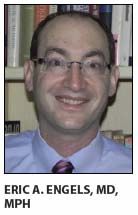With Longer Survival Rates, AIDS Patients Face Elevated Cancer Risk
Thanks to the widespread use of highly active antiretroviral therapy (HAART), AIDS patients continue to live longer after their initial diagnosis.
Thanks to the widespread use of highly active antiretroviral therapy (HAART), AIDS patients continue to live longer after their initial diagnosis. But longer survival with immune suppression, even when it’s substantially restored by HAART, also means that this population is at a greater risk for cancer, specifically Kaposi sarcoma, non-Hodgkin lymphoma (NHL), and cervical cancer (also known as AIDS-defining cancers).
A pair of recent studies took a closer look at the link between AIDS and cancer risk. A group of investigators from the National Cancer Institute (NCI) evaluated long-term cancer risk and also compared ages at diagnosis of AIDS patients and the general population.
Cancer Screening and Vaccines in the HIV Population
Dr. Engels and co-authors found an increased risk for anal cancer in HIV patients, but controversy persists about the benefits of regular screening. A study from Boston’s Harvard University looked at the clinical benefits of Pap tests, every two years, in HIV-positive homosexual and bisexual men for anal squamous intraepithelial lesions and anal squamous cell carcinoma. The researchers calculated a 2.7-month gain in quality-adjusted life expectancy when screening was done (JAMA. 1999;281:1822-9).
A separate study suggested that cytology screening was the best approach to identifying anal HPV and anal intraepithelial neoplasia in this at-risk population. But critics pointed out that there have been no prospective, randomized, controlled trials conducted to assess the effectiveness of anal cancer screening. Instead, proponents have relied on an analogy to cervical cancer screening as support (Ann Intern Med. 2008;149:300-6, and 2009;150:283-5).
While cervical cancer screening is recommended for women with HIV, there has still been a lack of decline in disease incidence, Dr. Engels’ group noted. The HPV vaccine may provide some benefit, “but its impact will not be immediately realized, and its efficacy in preventing infection in HIV-positive women…is not known,” they wrote.
Longer Life, Greater Risk

Using data from the HIV/AIDS Cancer Match Study, Edgar P. Simard, PhD, MPH, and colleagues focused on cancer risk for a period of 3 to 10 years after AIDS diagnosis and onset (they calculated the standardized incidence ratio, defined as the ratio of observed to expected number of cancer cases, as a measure of risk relative to that of the general population).
The study population consisted of 263,254 patients, 80.1% of whom were men. The median age at AIDS onset was 36 years. The observation time in the 6- to 10-year period was based mostly on people diagnosed from 1990 to 1995, wrote Dr. Simard from the NCI’s division of cancer epidemiology and genetics in Rockville, Md. His co-authors were Ruth M. Pfeiffer, PhD, and Eric A. Engels, MD, MPH (Arch Intern Med. 2010;70:1337-45).

The authors found that risks for two AIDS-defining cancers (Kaposi sarcoma and NHL) were significantly elevated in years 3 to 5 and in years 6 to 10 after AIDS onset. Also, risks were higher in AIDS patients than in the general population for NHL, including diffuse large B-cell NHL, Burkitt NHL, and central nervous system NHL. Cervical cancer risk was heightened after AIDS during years 3 to 5 and 6 to 10.
The group also compared cancer incidence in the 3 to 10 years after AIDS onset for the pre-HAART era (1990 to 1995) and the HAART era (1996 to 2006). Between those two landmark time periods, the incidence of Kaposi sarcoma declined by 80%, while NHL incidence dropped by 70%. However, among non–AIDS-defining malignancies, there was a three-fold increase in anal cancer between the pre-HAART and HAART eras.
In fact, the incidence of non–AIDS-defining cancers, including anal cancer and Hodgkin lymphoma, rose by 20% between the pre-HAART and HAART eras. The authors pointed out that the decline in AIDS-defining cancers may be linked to the effectiveness of HAART in improving immune function.
But the notable excess risk of other cancers (anus, penis, cervix, vagina, oral cavity) can be attributed to persistent infection with oncogenic human papillomavirus (HPV) subtypes. “The continued rise of anal cancer incidence in recent years, even in the presence of widespread HAART use, suggests that the key steps susceptible to immune control might have occurred years earlier,” they explained.
Prolonged survival of AIDS patients may then be driving the manifestation of invasive cancer.
VANTAGE POINT

DIRK P. DITTMER, PhDThe non-AIDS-defining cancers are here to stay
Even with the widespread administration of HAART, 10 times more people in the U.S. die of the classic, AIDS-defining cancers than they do any of the non–AIDS-defining cancers. Nevertheless, Dr. Simard and colleagues “demonstrate that HIV confers an increased cancer risk … it is unlikely that these trends that they have documented will change appreciably because of better HAART or better HAART adherence alone. The non–AIDS-defining cancers are here to stay,” wrote Dr. Dittmer in an accompanying editorial (Arch Intern Med. 2010; 170:1345-6).
“Perhaps in today’s non–AIDS-defining cancers we are seeing a second wave of immune-controlled cancers that break through the residual immune system that exists in patients undergoing HAART,” suggested Dr. Dittmer, who is an associate professor in the microbiology and immunology department at the University of North Carolina, Chapel Hill. He also is a member of the Lineberger Comprehensive Cancer Center and the Center for AIDS Research and of the AIDS malignancies consortium (AMC).
Anal cancer stands out among all the non–AIDS-defining cancers in the HAART era, and Dr. Dittmer asked if it should be added to the list of AIDS-defining cancers in the post-HAART era. He also said that two questions still needed to be answered: First, is there a pathophysiologic difference between cancers that develop in HIV-infected patients with long-term HAART exposure vs the general population? And second, if such a difference exists, can it be exploited to develop better therapies?
“Mere T-cell numbers do not fully explain cancer risk in the HAART era. We might need to look at the immune system functionally as well as in terms of immune repertoire,” he said.
Premature Aging Not a Concern Yet
Previous studies have found that people with HIV infection are diagnosed with lung, liver, and colon cancer as early as 20 years before the general population. But does this mean that HIV-positive patients are vulnerable to a syndrome of premature aging, thus increasing their cancer risk? Meredith S. Shiels, PhD, MHS, and colleagues also mined data from the US HIV/AIDS Cancer Match Study to compare the ages at diagnosis for 26 non–AIDS-defining cancers in both AIDS patients and the general population, after adjusting for age and other demographic characteristics. Dr. Pfeiffer and Dr. Engels served as co-authors on this study (Ann Intern Med. 2010;153:452-60).

The analysis included 212,055 people with AIDS who were followed for cancer during the HAART era. The median age at diagnosis was 38 years. The most common types of cancer were lung (24%), followed by anal cancer (11%) and Hodgkin’s lymphoma (9%).
Because HIV is generally acquired at a younger age, and because these patients have a shorter life expectancy, the proportion of AIDS patients who are older is far smaller than in the general population. For most types of cancer, the median observed age at diagnosis was about two decades younger among AIDS patients than in the general population, the authors reported.
But after adjusting for underlying population structures to remove any bias, they found a negligible difference between the ages of the two groups at cancer diagnosis. For example, for colon cancer, the median observed age at diagnosis in the AIDS population, and the median expected age at diagnosis, were identical at 52 years (P = .53). The authors also found no difference in the median ages at diagnosis in AIDS patients and in the general population for colon, prostate, or breast cancer (P > .001).
However, AIDS patients were diagnosed at a younger age compared with the general population for lung cancer (50 years vs 54 years) and anal cancer (42 vs 45 years; P < .001). The age at diagnosis for Hodgkin lymphoma was greater in the AIDS population (42 years vs 40 years; P < .001). The authors offered some possible explanations: (1) the effect of HIV on the development of these cancers, and (2) increased medical surveillance of AIDS patients, which results in a lead-time bias.
“Our results do not support including cancer as part of a general syndrome of premature aging in HIV-infected persons,” the authors wrote. AIDS patients may have been diagnosed with cancer at a younger age because there were very few older AIDS patients at the time of the cancer match study. As the AIDS population lives longer and continues to age, differences in age at cancer diagnosis will attenuate. Overall, their results do not support an accelerated cancer screening schedule in HIV-positive patients, although more aggressive screening for cervical or anal cancer may be advisable, they said.
VANTAGE POINT


An ‘important stepping stone’ to clarifying premature aging in HIV
The hypothesis of premature aging in HIV infection-that comorbid conditions seem to be more common in these patients and occur at a younger age than in the general population-is an intriguing one, but it remains a hypothesis, wrote Dr. Martin and Dr. Volberding. The study results of Dr. Shiels and colleagues “do not support premature aging as a cause of cancer among HIV-infected persons. The article … is an important stepping stone in our path to clarifying a relationship of HIV with premature aging,” they said (Ann Intern Med 2010;153:477-8).
In order to establish accelerated aging as a true complication of HIV infection, there needs to be a better understand of the normal biological aging process, they explained. In addition, research in this area must come to a consensus about definitions for HIV-related aging and offer valid epidemiologic studies to show examples of premature aging.